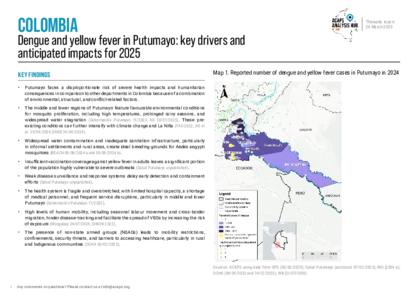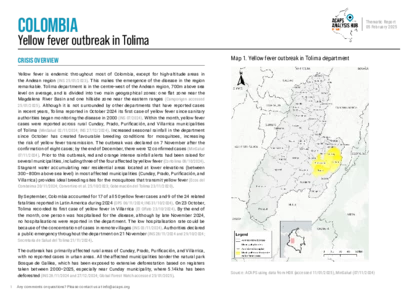Latest updates on country situation
25 February 2025
Since 11 February 2025, heavy rains have caused widespread damage in the department of Nariño, southwestern Colombia, affecting around 19,000 people by 21 February. Heavy rains and flooding have destroyed homes and public infrastructure and caused crop and livelihood losses. The municipalities of Barbacoas, Roberto Payán, and Tumaco have been the hardest hit. In Tumaco, where a state of emergency has been declared, damage to at least 15 educational institutions has forced school closures, affecting more than 2,600 students. The floods have heightened the challenges faced by communities in Nariño, particularly among agricultural, Afrodescendant, and Indigenous groups. The most urgent needs include food, safe water, healthcare, and education. (ET 20/02/2025, ECHO 24/02/2025, OCHA 21/02/2025)
17 February 2025
Since January 2025, people living in Chocó department, western Colombia, have been facing increasing insecurity owing to non-state armed group activity. These include attacks on civilians, clashes among armed groups, and movement restrictions and confinements. Since the beginning of February, fighting between armed groups in southern Chocó has displaced around 5,000 individuals. In mid-February, the armed group National Liberation Army (ELN) announced an armed strike in the department, ordering the population to remain indoors. The strike has been affecting around 430,000 people. Coupled with the increasing insecurity, the armed strike is hampering people's access to services and assistance. Communities urgently need food, health services, and protection. (OCHA accessed 19/02/2025, Caracol Radio 18/02/2025, El Colombiano 17/02/2025)
20 January 2025
Since mid-January 2025, the Catatumbo region in Norte de Santander, Colombia, has been experiencing intensified violence. Two non-state armed groups – the National Liberation Army and dissidents from the Revolutionary Armed Forces of Colombia – have been engaged in conflict, leading to the displacement of over 18,700 people and the confinement of 1,260 individuals. Among those affected are Indigenous communities, Venezuelan refugees, and local communities. Thousands have sought refuge in shelters in Cúcuta, Ocaña, and Tibú, while others fled across the border to Venezuela.
Armed group activity, mobility restrictions, and targeted attacks have disrupted basic services, electricity, and access to healthcare. Humanitarian needs remain acute, including food, shelter, water, and healthcare. This violence reflects a broader deterioration across Colombia, with multiple frontlines escalating simultaneously, increasing protection risks for peace accord signatories and community leaders.
11 November 2024
Heavy rains in Colombia have led to widespread flooding in recent weeks, affecting over 230,000 people by 11 November 2024 and forcing the Government to declare a national state of disaster. The hardest-hit areas include Chocó department in the west, where riverine flooding has restricted mobility and isolated towns, and La Guajira department in the north, where heavy rains have blocked main roads and destroyed Indigenous communities' crops. People in both departments require humanitarian aid to access food and healthcare services. (CNN 10/11/2024, France 24 11/11/2024, El Colombiano 10/11/2024)
20 May 2024
2023 recorded 58,469 people displaced and 100,402 people confined in Colombia, a 14% decrease and 43% increase, respectively, compared to 2022. Clashes between non-state armed groups and insecurity were the primary causes behind both. Departments such as Cauca, Chocó, and Valle del Cauca, in western Colombia were the regions most affected. Those currently displaced and confined require access to food, WASH services, shelter, and ways to return to their homes and daily lives. (UNHCR 20/05/2024, IDMC accessed 21/05/2024)
04 March 2024
Despite a slight improvement in violence indicators, Colombia continues to grapple with humanitarian challenges. In January 2024, 12,600 individuals experienced displacement or forced confinement, primarily in the west. Of these, 8,600 were confined (69%) and 3,900 displaced (31%). Chocó witnessed the highest confinement rates, with up to 35,000 affected individuals in 2023. In Caquetá, 36,000 individuals faced mobility restrictions because of an armed strike earlier in 2024. Confrontations among armed groups and with state forces remain the primary cause of displacement and confinement. The affected populations, particularly those confined, urgently require access to food and protection from violence. (OCHA 01/03/2024, Radio Nacional 15/02/2024)
05 February 2024
In the northern Colombian department of La Guajira, 77% of rural households do not have access to clean drinking water and WASH services, putting them at a higher risk of contracting waterborne diseases and diarrhoea. In 2024, 260,000 people are estimated to require food assistance in the department, with 46% (120,000) coming from indigenous communities. These groups require humanitarian assistance in accessing food, drinking water, and WASH services. (OPS et al. 05/02/2024; FSC/Nutrition Cluster 03/01/2024)
current crises
in
Colombia
These crises have been identified through the INFORM Severity Index, a tool for measuring and comparing the severity of humanitarian crises globally.
COL001 - Complex crisis
Last updated 31/03/2025
Drivers
Conflict
Violence
Floods
Displacement
Crisis level
Country
Severity level
3.9 High
Access constraints
3.0
COL002 - Venezuelan refugees
Last updated 31/03/2025
Drivers
Displacement
Crisis level
Country
Severity level
3.3 High
Access constraints
2.0
Analysis products
on
Colombia
26 March 2025
Colombia: Dengue and yellow fever in Putumayo - key drivers and anticipated impacts for 2025
DOCUMENT / PDF / 2 MB
This report analyses the anticipated humanitarian impacts of a potential increase in dengue and yellow fever cases in Putumayo during 2025. It analyses how key drivers, structural vulnerabilities, and aggravating factors could shape the spread of these vector-borne diseases (VBDs) and their humanitarian impacts in this scenario.
Attached resources
05 February 2025
Colombia: Yellow fever outbreak in Tolima
DOCUMENT / PDF / 809 KB
Yellow fever is endemic throughout most of Colombia, except for high-altitude areas in the Andean region. This makes the emergence of the disease in the region remarkable.
Attached resources
02 December 2024
Colombia: Individual displacement in Bogotá, Buenaventura, Florencia and Ocaña
DOCUMENT / PDF / 7 MB
This report aims to assess the needs of IDPs experiencing individual displacement because of conflict in Colombia, with a specific focus on the municipalities of Bogotá, Buenaventura, Florencia, and Ocaña.
Attached resources
06 August 2024
Colombia: drought and flooding in the Orinoquia region
DOCUMENT / PDF / 635 KB
The onset of El Niño in Colombia in November 2023 led to dry conditions in the Orinoquia region. These conditions resulted in food insecurity, water shortages and rationing, and wildfires, affecting an estimated 195,000 people, predominantly in Arauca department.
Attached resources
02 August 2024
Colombia: Flooding in La Mojana
DOCUMENT / PDF / 1 MB
Since 2021, La Mojana has experienced recurrent flooding; the Cara de Gato dam in San Jacinto del Cauca municipality, Bolívar department, has broken down on several occasions under heavy rains and high river discharge in the subregion.






